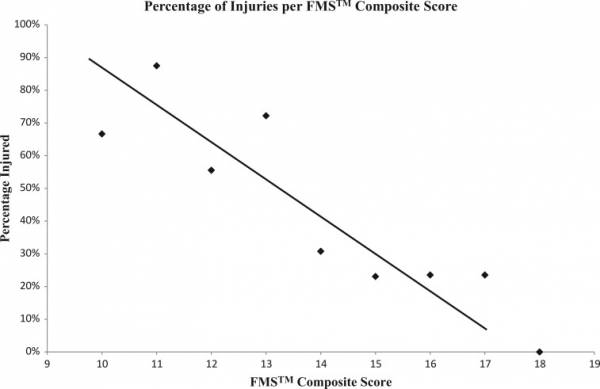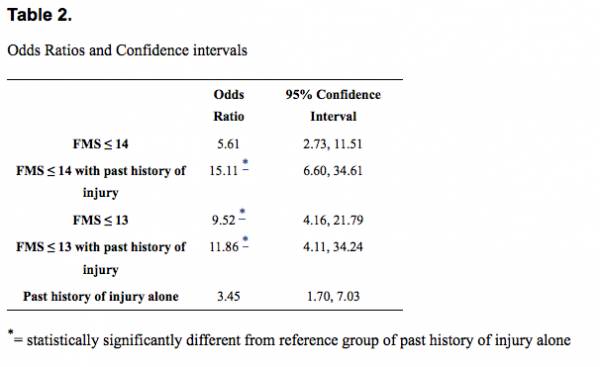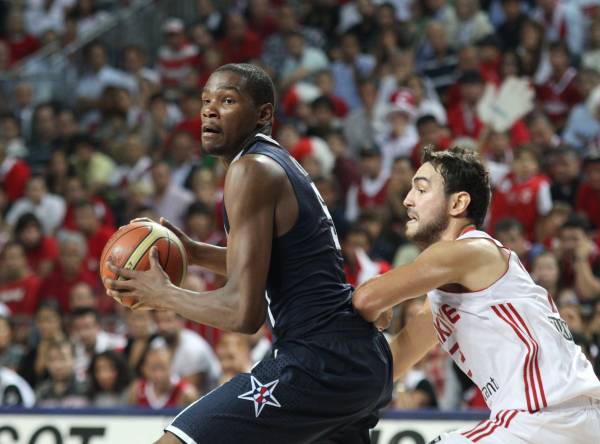Poor movement patterns have been shown to increase the risk of injury. The Functional Movement Screen (FMS) is a validated measure used by many sports teams to test movement patterns and predict injury. Recent research indicates a low score possibly resulting from a previous injury might increase the likelihood of a future injury even more.
Kevin Durant’s Foot Injury
NBA player Kevin Durant may not be able to play basketball again this season due to complications related to a foot injury. The original injury was expected to have a full recovery in six to eight weeks. But then his teammate Russell Westbrook was also injured and the team was compiling a bad record.
Durant rushed back to play, and soon after he sprained his ankle. By playing before being completely healed, his injury may have compounded. He has been in and out throughout the season and now he may be done.
NBA player Kevin Durant has been in and out this season and may be done.
The FMS Can Help
Recent research by Michael Garrison and colleagues might provide a background on how injury affects future injury. These researchers tracked 160 collegiate male and female athletes throughout the season. The athletes played a variety of sports. 52 of the athletes were injured throughout the season.
Prior to tracking, all athletes were given the FMS to assess their movement. This test is made up of seven movements that test mobility, stability, coordination, and asymmetry. Athletes can score from zero to 21, with 21 being perfect.
“Durant rushed back to play, and soon after he sprained his ankle. By playing before being completely healed, his injury may have compounded. He has been in and out throughout the season and now he may be done.”
The FMS score is a good predictor of injury. Lower scores on the FMS are associated with higher injury rates. The idea that poorer movement patterns lead to more injuries has been found previously and is probably something you already thought makes sense. However, the researchers found something unique in regards to previous injury status combined with poor movement.

Percentage of injuries in relation to scores on the FMS
Building on a Poor Foundation
Past injury and low FMS score both (individually) affected injury rate. Previous injury alone increased the risk of future injury by 3.5 times (i.e. a person with a previous injury is 3.5 times more likely to receive another injury). A FMS score below fourteen increased injury by about 5.6 times. However, if you have both a previous injury and a low score, the likelihood of a future injury becomes fifteen times greater. This affect is greater than the two combined and the two factors might compound each other.

This graph demonstrates the lower odds of injury with higher FMS scores
Does an injury lead to poor movement patterns, which then increase the risk of future injury? In Kevin Durant’s case, he might have been trying to protect his injured foot and moved differently. He said, “It shouldn’t be [serious]. Just a sprained ankle. But when you sprain an ankle with the injury I had, it puts more pressure on that side of the foot.” It sounds like he is indicating that he has to move differently because of the compounding of injuries. This overcompensation might be one of the reasons he has not been able to come back this season.

Durant playing on the the FIBA World Championships in 2010
Summary
As you can probably already guess, poor movement patterns assessed by the FMS lead to a greater risk of injury. However, the compounding effects of previous injury may lead to poor movement, which then increase the risk of injury even further.
The take-home message is to make sure you are fully recovered from injuries so you don’t impair your movement pattern. If you have a previous injury that impacts your movement, then you could be training poor movement patterns.
References:
1. Garrison, Michael, Richard Westrick, Michael R. Johnson, and Jonathan Benenson. 2015. “Association between the Functional Movement Screen and Injury Development in College Athletes.” International Journal of Sports Physical Therapy 10 (1): 21–28.
Further Reading:
- Exposing the Importance of the Functional Movement Screen
- Can the Functional Movement Screen (FMS) Actually Determine Ability?
- Use the FMS to Assess Mobility, Not Performance
- What’s New on Breaking Muscle Today
Photo 1 by By Keith Allison from Owings Mills, USA via Wikimedia Commons.
Photo 2 courtesy of Shutterstock.






